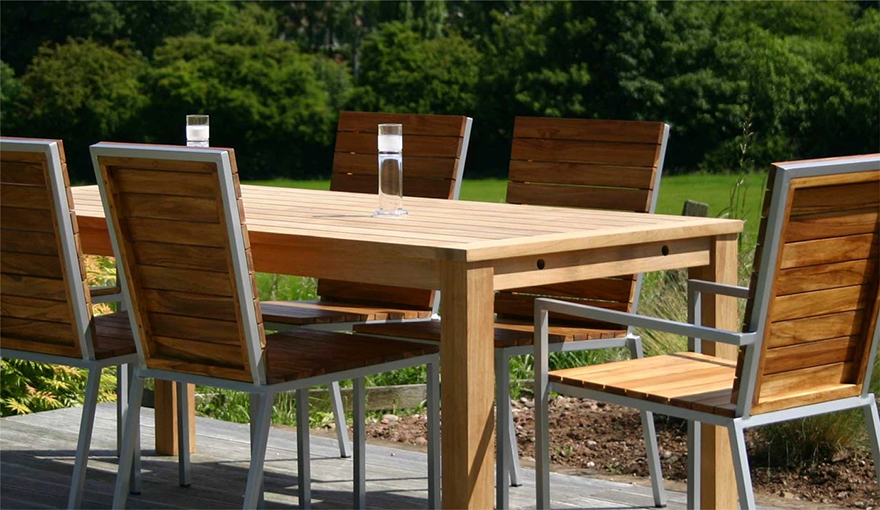An Introduction To Wood Species, Part 10: Teak

This Wood Species series of entries comes to us from guest writer Rob Wilkey, an Atlanta-based woodworker and industrial designer whose expertise is in small home goods, furniture, and large installations.
Well folks, we've arrived at the final installment of this series on commonly imported wood species. This week's featured species:

Like many other popular imports, teak has several impostors. Its name is used to sell a number of other species such as 'Brazilian Teak' (Cumaru) and 'African Teak' (Afrormosia). Genuine teak, also called Burma Teak, consists of only one species: Tectona grandis. This wood grows naturally in the tropical regions north of the Indian Ocean, but is now cultivated on plantations in Asia, Africa and South America. In fact, naturally-occurring or 'old-growth' teak is very difficult to find nowadays as plantation teak has dominated the marketplace. While plantation-grown teak has the same working properties as natural teak, it tends to lack the deep coloration and beautiful grain patterns found on old-growth teak. One property that all kinds of teak possess, however, is an extremely high resistance to rot and decay, making it the lumber of choice where water exposure is an issue. Wooden boat decks are almost always constructed using teak planks.

Teak is easy to work, relatively lightweight, and suffers from minimal seasonal movement. With a Janka rating of 1000lbf, the wood is just hard enough to resist dents and scratches while still being easy to cut and shape. Teak is diffuse-porous with medium pores, and is usually straight-grained. All of these factors make the wood ideal for most woodworking processes, however it will not sand to a smooth surface due to the numerous open pores. Teak's incredible decay resistance is mostly attributable to the wood's high oil content which, oddly, has little negative effect on gluing the wood. While other woods share teak's high decay resistance, few are as abundant, workable, and lightweight as teak. The low weight of teak is especially important for its use on outdoor furniture. The weight difference between teak and other weatherproof woods, such as ipe, can mean a difference of several pounds on something as small as a dining chair.

Although teak is abundant and sustainably grown on thousands of plantations, the wood is still very expensive. Boards are available in large widths and lengths, making it a fantastic choice for large outdoor installations. And, although such structures will last for generations with little maintenance, the initial cost can be substantial. Teak is generally regarded as somewhat of a status icon in this matter, as much less expensive lumbers are available for the same applications.

Despite is high durability and water resistance, teak is still subject to an effect known as sun fading. For all kinds of lumber, prolonged sunlight exposure will fade the surface of the wood until it is almost solid gray. Teak can easily be restored from this state with some quick sanding and a light application of sealant, preserving the wood's natural color for several more years.

Teak may be prohibitively expensive for some, but no other wood exhibits such a fantastic combination of workability, weather resistance, and beauty. As with other expensive imports, this wood should be reserved for use on heirloom-quality objects and installations.
This concludes the introduction to wood species series. If you have any questions about these species, or others that I haven't covered, I invite you to check out The Wood Database, or email me at robdwilkey [at] gmail -dot- com.
Material Matters: Wood
An Introduction to Wood Species:
» Part 1: Properties & Terminology
» Part 2: Pine
» Part 3: Oak
» Part 4: Maple
» Part 5: Walnut
» Part 6: Cherry
» Part 7: Mahogany
» Part 8: Rosewood
» Part 9: Ebony
» Part 10: Teak
How Logs Are Turned into Boards:
» Part 1: Plainsawn
» Part 2: Quartersawn
» Part 3: Riftsawn
Wood Movement:
» Why Does Wood Move?
» Controlling Wood Movement: The Drying Process
» Dealing with Wood Movement: Design and Understanding
-
o1Favorite This
-
Q4Comment
K
{Welcome
Create a Core77 Account
Already have an account? Sign In
By creating a Core77 account you confirm that you accept the Terms of Use
K
Reset Password
Please enter your email and we will send an email to reset your password.


Comments
Kindly answer to me this question: What is the differences between 3 species of Teak: African Teak, Brazil Teak and Burma Teak?